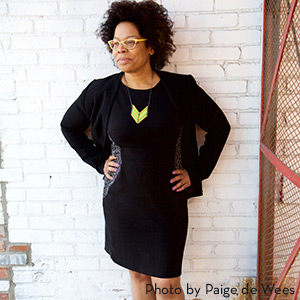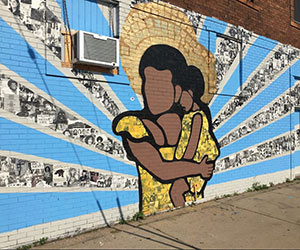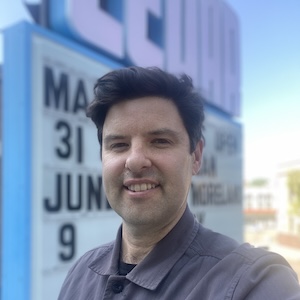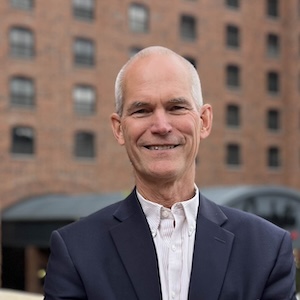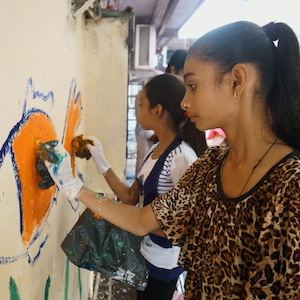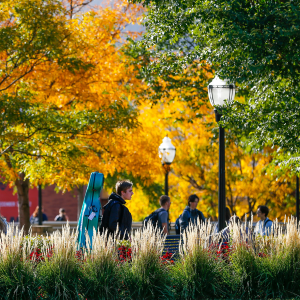DeAnna Cummings, Faculty Member and CEO, Juxtaposition Arts
“The arts aren’t separate from the rest of the world. The big trends playing out in the business, political, and social sectors are the same trends happening in the arts,” says DeAnna Cummings, Arts and Cultural Leadership faculty member and CEO of Juxtaposition Arts, an organization that prepares young urban artists to enter the creative workforce through education, employment, and empowerment.
Cummings teaches the popular course “Trends and Impacts in Arts and Cultural Leadership and Management,” where she uses a “learning through conversation” seminar approach. Students are actively engaged, individually and collectively, through shared assignments, guest speakers, and site visits. They discuss trends in the arts in general, education, funding, the social and political landscape, and the history of the arts.
So what are the big issues today?
“Technology is one,” Cummings says. “How do we keep people’s attention? What are we doing that is more appealing than Netflix and a glass of wine? (The arts) has a cost of participation that doesn’t only equate to dollars but are costs nonetheless—we have the cost of not only buying tickets, but getting dressed, going to the venue, finding parking, and sitting next to strangers. These are high psychological costs in a day and age where technology has given us access to practically the entire history of film and music while sitting in our living rooms.”
In other words, the arts has to up their game in order to remain competitive and relevant. Artists and administrators need to use technology wisely, to bring art to each other, patrons, and donors where they are. Technology can often bring people in, but the challenge is to keep the connection authentic and unique.
“Art needs to be outside of the circle of the makers and institutions,” she continues. “That kind of structure of artistic production is not the future. Think bigger.”
"If it only matters to you and nobody else connects with it, what difference does it make? Is it art?”
The world is changing. Demographics in the US are shifting. Why does that matter in the arts? Growing diversity in populations means that the western European institutional model and canon has become less relevant, Cummings explains: “People want to see themselves represented in the cultural products that we are presenting. They need to be considered in terms of what we make and present.”
The takeaway is to remain nimble, flexible, and forward thinking. “Know yourself,” Cummings advises. “Think about how to bring the best of yourself to whatever you’re doing. As leaders we sometimes feel like we must know everything, but we don’t. When we know our strengths and weaknesses, we’re better able to lead collaboratively. People want to be involved, not directed.”
What If?
Cummings's day-to-day work at Juxtaposition Arts can be very high stakes, where her opinions and decisions have real consequences. “I like being in higher ed because it gives me a chance to be away from that and just think, ‘What if?’ You can dream in the classroom; nobody is going to lose their job or lose funding. We need more spaces like that.”
At Juxtaposition Arts, Cummings and her team combine art and design education with a social-enterprise business model. Students have the opportunity to be employed while learning and teaching design, production, and marketing in a professional studio. The products and services are then sold to local and national customers.
“I like being in higher ed because it gives me a chance to... just think, ‘What if?’ ”
“JXTA understands that business as usual in the arts is a thing of the past. You have to have a firm grasp of history and be able to put your finger on potential trends in order to be responsive.”
Cummings envisions replicating Juxtaposition’s model in other places. She recently received a grant to explore this idea by traveling and seeing examples of similar models that have successfully replicated.*
“We build on history at JXTA, are wide open in our dreams, and then get to the business of doing the work to make the dreams reality.”
Photos: Top, Graffiti wall mural by Tats Cur; middle, DeAnna Cummings photo by Paige de Wees; bottom, Who We Are mural designed by youth and adult artists in JXTA's Public Art Studio
* Cummings recently was one of ten national leaders to receive the Local Initiatives Support Corporation (LISC) Rubinger Community Fellowship, which "recognizes their accomplishments to date and invests in their growth as leaders and in the future of community development." The award will "support a special project of their choice that addresses critical demands in rural and urban America."

